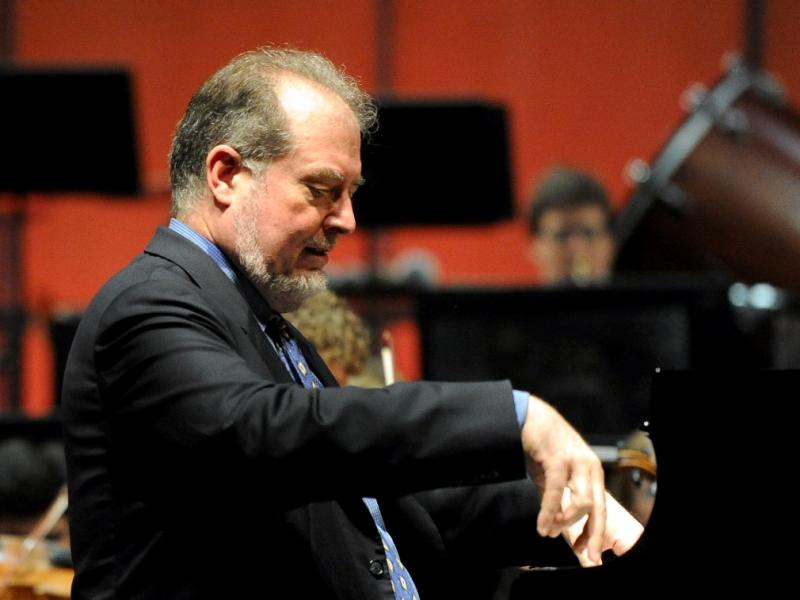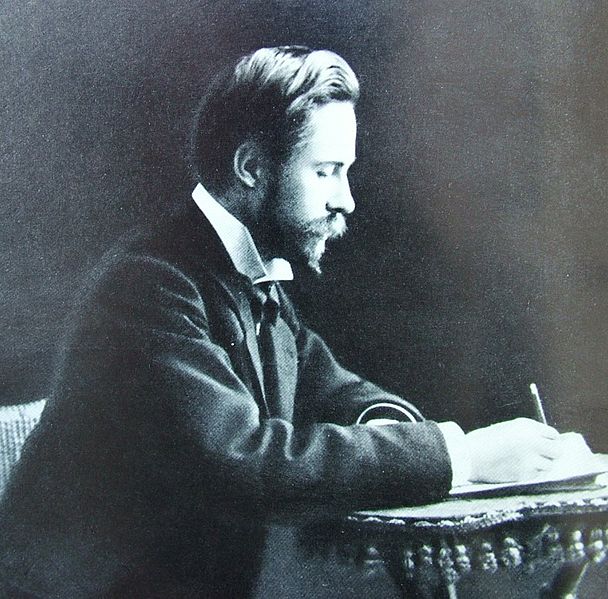Scriabin Anniversary Recital, Ohlsson, Wigmore Hall | reviews, news & interviews
Scriabin Anniversary Recital, Ohlsson, Wigmore Hall
Scriabin Anniversary Recital, Ohlsson, Wigmore Hall
Flame control and a big orchestral sound from a master pianist

Of Alexander Nikolayevich Scriabin, who died 100 years ago aged 43, it was said at one time (by Rimsky-Korsakov) that he was “warped, a poser and opinionated”, at another (by Boris Pasternak) that he could seem “as tranquil and lucent as God resting from his labours on the seventh day”. Only Pasternak’s definition applies to the magnificence of Garrick Ohlsson, a lion couchant who can use his wings to fly into the sun when Scriabin so requires.
There was much to celebrate here, despite the occasional dissonant gloom of Scriabin’s later style. After closing the orchestral year in unforgettably lucid might with Busoni’s 80-minute Piano Concerto, Ohlsson was back on Scriabin’s birthday – actually Christmas Day according to the Julian calendar operating in Russia back in 1872, so no wonder the composer developed Messianic tendencies.
The translucent, lovely side we heard in several heart-stopping modulations at the heart of the D flat major Étude, Op. 8 No. 10, in the lyric bliss minutes into the Second Sonata and above all in the syncopated Icarus flights at the ends of the Fourth and Fifth Sonatas. The fall came in the anguish of the Sixth, by which time in the programme we might have heard a bit too much already of what Prokofiev intelligently described as the “millstone round Scriabin’s neck” of his search for a new harmonic basis, “making it difficult for invention in the realm of melody and, chiefly, the movement of voices”.
 Still, in each new sonata up to the Tenth of 1913, there is always something fresh to drive Scriabin towards what we might think of as the abyss of atonality, but which he believed was a new synthetic religion (the composer, pictured right, in 1905). The metaphysics, not to mention the outlandish French score instructions – on the bottom line of the Sixth’s opening page we get “souffle mystérieux”, “onde caressante” and “concentré” – aren’t at the forefront of Ohlsson’s shining enlightenment. Rarely, even from the Russian school, has a more opulent, full orchestral sound been won – never forced – from from a piano. Ohlsson would fill the Albert Hall beautifully (how about two late-night Proms? I guess it’s too late to think of that now for anniversary year).
Still, in each new sonata up to the Tenth of 1913, there is always something fresh to drive Scriabin towards what we might think of as the abyss of atonality, but which he believed was a new synthetic religion (the composer, pictured right, in 1905). The metaphysics, not to mention the outlandish French score instructions – on the bottom line of the Sixth’s opening page we get “souffle mystérieux”, “onde caressante” and “concentré” – aren’t at the forefront of Ohlsson’s shining enlightenment. Rarely, even from the Russian school, has a more opulent, full orchestral sound been won – never forced – from from a piano. Ohlsson would fill the Albert Hall beautifully (how about two late-night Proms? I guess it’s too late to think of that now for anniversary year).
Always the ornamental flames are subsidiary to the main lines; fires blaze up from an especially vivid bass to the top of the range, astoundingly so in one firework towards the end of the Seventh (“White Mass”) Sonata, chord clusters never sound ugly and clarity is paramount even in the most gigantic washes of sound.
Though I feel, as I did in the Busoni Concerto, that Ohlsson is more a Prometheus than an Ariel in the music of the spheres, he is perfectly capable of pianissimo magic. Désir, the Scriabinesque mystery in a nutshell, was aphoristic perfection and even in the opening A minor Prelude, relative juvenilia, there was space enough to hear the kind of suspensions which would uproot tonality altogether in the later pieces. The gift to be simple and inward could not have been more poetically delivered than in the first of the three encores, the famous Étude Op. 2 No. 1 composed when Scriabin was only 15. What a strange journey he took after that, and how effortlessly Ohlsson seemed to embrace it all. The only problem was that I wanted his second instalment tonight, not in April, but I’ll just have to wait.
- Listen to this concert for the next month on the BBC Radio 3 iPlayer
- Ohlsson's second Scriabin programme is on 27 April (not available on the Wigmore website)
Next page: Ohlsson introduces three Scriabin piecesGarrick Ohlsson introduces three Scriabin pieces
rating
Explore topics
Share this article
The future of Arts Journalism
You can stop theartsdesk.com closing!
We urgently need financing to survive. Our fundraising drive has thus far raised £33,000 but we need to reach £100,000 or we will be forced to close. Please contribute here: https://gofund.me/c3f6033d
And if you can forward this information to anyone who might assist, we’d be grateful.

Subscribe to theartsdesk.com
Thank you for continuing to read our work on theartsdesk.com. For unlimited access to every article in its entirety, including our archive of more than 15,000 pieces, we're asking for £5 per month or £40 per year. We feel it's a very good deal, and hope you do too.
To take a subscription now simply click here.
And if you're looking for that extra gift for a friend or family member, why not treat them to a theartsdesk.com gift subscription?
more Classical music
 Connolly, BBC Philharmonic, Paterson, Bridgewater Hall, Manchester review - a journey through French splendours
Magic in lesser-known works of Duruflé and Chausson
Connolly, BBC Philharmonic, Paterson, Bridgewater Hall, Manchester review - a journey through French splendours
Magic in lesser-known works of Duruflé and Chausson
 Biss, National Symphony Orchestra, Kuokman, NCH Dublin review - full house goes wild for vivid epics
Passionate and precise playing of Brahms and Berlioz under a dancing master
Biss, National Symphony Orchestra, Kuokman, NCH Dublin review - full house goes wild for vivid epics
Passionate and precise playing of Brahms and Berlioz under a dancing master
 Verdi Requiem, Philharmonia, Muti, RFH review - new sparks from an old flame
Discoveries on a veteran maestro's epic journey
Verdi Requiem, Philharmonia, Muti, RFH review - new sparks from an old flame
Discoveries on a veteran maestro's epic journey
 Batsashvili, Hallé, Wong, Bridgewater Hall, Manchester review - a star in the piano universe
The Georgian pianist brings precision and freedom to Liszt’s warhorses
Batsashvili, Hallé, Wong, Bridgewater Hall, Manchester review - a star in the piano universe
The Georgian pianist brings precision and freedom to Liszt’s warhorses
 Naumov, SCO, Egarr, Queen's Hall, Edinburgh review - orchestral magic rescues some punishing music
Hard-driven Beethoven, monotonous Eötvös, some light from Kernis
Naumov, SCO, Egarr, Queen's Hall, Edinburgh review - orchestral magic rescues some punishing music
Hard-driven Beethoven, monotonous Eötvös, some light from Kernis
 Classical CDs: Shipping lines, sabre dances and sea lice
Neglected piano concertos, Italian art songs and new music for trombones
Classical CDs: Shipping lines, sabre dances and sea lice
Neglected piano concertos, Italian art songs and new music for trombones
 Il trionfo del Tempo e del Disinganno, Irish Baroque Orchestra, Whelan, St George’s Hanover Square review - Handel’s journey of a soul
Pleasure gets the best deal despite Beauty’s struggle to higher things
Il trionfo del Tempo e del Disinganno, Irish Baroque Orchestra, Whelan, St George’s Hanover Square review - Handel’s journey of a soul
Pleasure gets the best deal despite Beauty’s struggle to higher things
 Uproar, Rafferty, Royal Welsh College, Cardiff review - colourful new inventions inspired by Ligeti
Unfussy professionalism from Wales-based new music ensemble
Uproar, Rafferty, Royal Welsh College, Cardiff review - colourful new inventions inspired by Ligeti
Unfussy professionalism from Wales-based new music ensemble
 Attacca Quartet, Kings Place review - bridging the centuries in sound
Grammy-winning quartet bring more American punch than Gallic je-ne-sais-quoi to Ravel
Attacca Quartet, Kings Place review - bridging the centuries in sound
Grammy-winning quartet bring more American punch than Gallic je-ne-sais-quoi to Ravel
 Manchester Collective, RNCM review - exploring new territory
The string quartet – plus percussion and electronics – goes on a journey
Manchester Collective, RNCM review - exploring new territory
The string quartet – plus percussion and electronics – goes on a journey
 Bavouzet, BBCSO, Stasevska, Barbican review - ardent souls in mythic magic
Vivid realisation of fantastical masterpieces by Bartók, Ravel and Janáček
Bavouzet, BBCSO, Stasevska, Barbican review - ardent souls in mythic magic
Vivid realisation of fantastical masterpieces by Bartók, Ravel and Janáček

Add comment